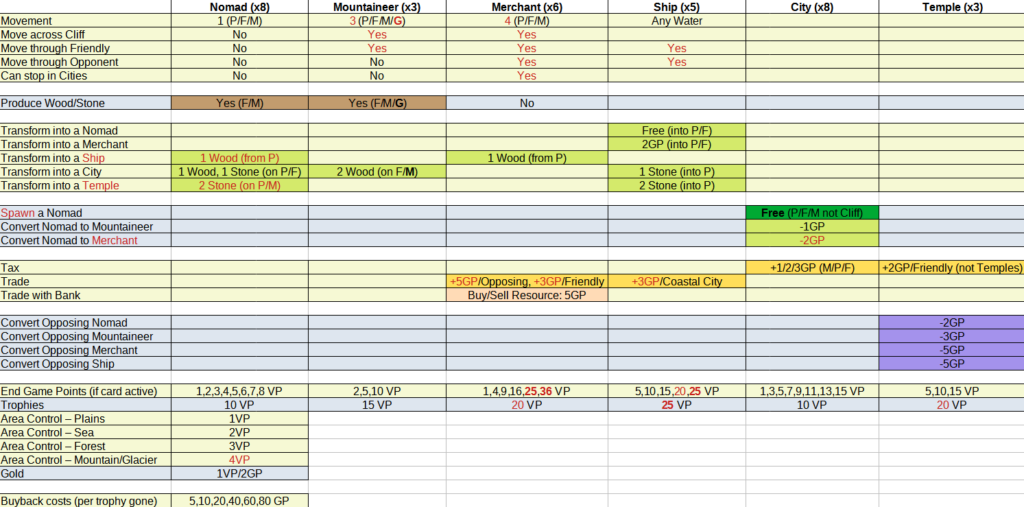Game
Worker placement with bonus actions on Recall
Go clockwise and on your turn either play a unit or regroup
- Place a Unit (from your Ready Area, into the realm)
- Gain 1 treasure token from the top of a stack
- Placement Rules
- First placement after Regroup – anywhere unoccupied (dwellings don’t count as occupied)
- Warrior – tile can be occupied
- Subsequent placement – adjacent and not occupied by yourself
- Dragon – up to 2 tiles away
- Wizard – teleport anywhere unoccupied (if placing adjacent it doesn’t have to be unoccupied, only when teleporting)
- Tile type has an effect
- Mage Tower – spend 2 resources, get 3 magic cards, discard 1
- Summoning Portal – spend cost, move unit to Ready Area
- Mill – spend cost, convert a worker into a dwelling
- Choose a worker in a realm, Pay cost on the tile, place roof on worker
- Score 2VP per adjacent ruin (mill, dungeon, etc), Score 2VP per adjacent dwelling
- Progress up Elemental Track as pictured on tile
- Dungeon – expand map, get 2 adventure cards
- Take top tile from tile stock, place it, populate treasure/monster
- Take an adventure card from the market and progress up Elemental Track
- Optionally take another adventure card (and progress up track), or discard one from the market
- Repopulate adventure card market
- Fortress – spend 2 resources, get 2 gold (Gold is a wild resource)
- Oracle – pay cost to gain 1 adventure card or take 1 magic card
- Lair – spawns a monster
- Regroup
- Retrieve units from tiles, onto cards to take actions, or into Ready Area
- e.g. on starter card there are actions for Summon, Gather, and Dwell
- Retrieve units from underworld into Ready Area (no card actions allowed)
- Retrieve units from cards into Ready Area
- If you have any, return Merceneries to supply
Game ends on 6th dwelling or realm tile stock depleted
During Play
- Battles
- Triggered by placing a unit in an occupied tile, tile action resolved first
- Adjacent units may join (even those uninvolved initially), in turn order, finishing with active player. This is a one-time decision.
- Battle dice: 1 per unit/dwelling/adjacent dwelling, 2 for warrior, 3 for dragon
- Spend swords (and/or spells and/or abilities) for additional dice, in turn order, finishing with active player. This is a one-time decision.
- Roll dice. Single highest dice wins (ties go to next highest dice etc). Everyone loses tie.
- Winner goes up Glory track for a bonus (if monster beaten, can progress up Elemental track instead)
- Loser units go to underworld, Gain 1 sword per unit
- Adventure Cards, some special types:
- Doorways – these give bonus if you’re highest on their corresponding Elemental track
- Vaults – bonuses at end of game
- Auras – attach to existing cards (as a free action), for a modifier
- Monsters
- Going adjacent to a monster causes them to Rush in
- They have different abilities
- Monsters don’t go to the underworld, simply set them aside when destroyed
- You can dominate a monster, they become yours to control until destroyed
- chain symbol indicates abilities that apply while being dominated
- Some effects send monster back to lair, units go to underworld
- Mercenaries
- Pay to hire until Regroup as a free action (or with an orb to keep)
- Minotaur – has monster Rush ability
- Shapeshifter – use another units ability
- Magic Cards
- Obtained from Mage Tower
- Hand limit of 7
- Can be spent as resources
- Spells – various effects, read the card, some have a cost
- Quests – gain points during the game for completing goals
- Prophecies – end of game points for completing goals
- Free Actions
- Treasure token – discard for pictured resource
- Treasure token – place in a slot
- Play a magic card
- Hire a Mercenary
- Spend an Orb
- Choose a reward from Orb reward market
- Slot Orb into Tableau
- Slot Orb into Adventure card
- Slot Orb to permenantly hire Mercenary
- Treasure chest symbol (looks a bit like a pie) means any resource
- Resource limit of 5 per type
Score Points From
- During Game
- Complete Quests (from magic cards, from Mage Tower)
- Glory Track rewards
- Orb bonuses
- Tableau actions
- Monster effects
- End of Game
- Unspent Orbs = 1VP
- Complete Prophecies(from magic cards, from Mage Tower)
- Elemental Track (1VP per rank), progressed up via:
- adventure cards, from Dungeon exploring
- creating dwelling, from Mill tile or Dwell action
- Dwellings = 1VP per rank on corresponding Elemental track
- Tableau cards = 1VP per rank on corresponding Elemental track
- limit to scoring 3 cards per constructed dwelling (i.e. 4 dwellings = 12 cards)
- Vault adventure cards
Tips
- Different factions have different abilities – read the mat and take advantage!
- Familiarise yourself with the adventure card market throughout the game
- Elemental track is critical for end game scoring
- You can only progress up 4 tracks
- Pick tracks based on tiles you’re dwelling in and adventure cards taken
- Get magic cards throughout, they’re useful and give end of game scoring
- First placement:
- look for tiles to dwell in with many adjacent ruins (2VP each) – don’t rush to dwell if not scoring
- Early game
- get units out (target summoning portal) – units get bonus actions on recall
- if there are worthwhile adventure cards then go to the Dungeon
- being able to get resources as part of recall is important, look for adventure cards to do this
- Remember magic cards can be spent as resources

